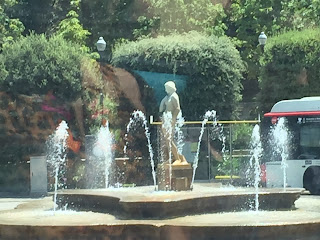There are some things that the Spanish do way better than we do and there are some places where our culture has the upper hand - it goes both ways. For example, Spain is a safe country in terms of crime and violence. They don't have pistol-waving maniacs causing mayhem nor do they have the gang and drug violence. You are very safe from those sorts of things. But, on the other hand, it is the little things that get you. A fellow student tripped on a little rise in a doorway the other day and took a nasty tumble. I had an incident my third day here where I stumbled and there was no handrail on the staircase, so I fell and bruised myself up terribly. It was a precursor to the really serious injury I had last Saturday in Barcelona.
So why am I telling you this? I'm hoping that next year's NSE scholarship winners will stop by and read this article because I have some important advice for you in the matter of healthcare and reduced mobility issues.
1. Your health insurance is probably not going to be accepted here. So, if you should find yourself in a serious situation, you need to know you can pay for your healthcare out of pocket. Get a credit card with some room on it, just in case. Your insurance company back home will probably reimburse you later, but make sure you have cash or credit on hand to pay your costs up front. My trip to the emergency room, including X-rays, shots, and prescription medicine cost about $600. This is a bargain compared to what we pay in the US, but it still can pinch when it comes out of pocket.
2. If you are experiencing ANY orthopedic issues, please please please see your doctor ahead of time and let him/her know that you will be walking a couple miles two and from school every day on hilly terrain. If you have hip, knee, or feet problems this can be very difficult. Get your braces, orthotics, and whatever else you need ahead of time.
3. Most of Madrid was put together a long time ago, before universal access was a consideration. In other words, many places are not handicap-friendly. They are making an effort and there are many places with elevators and ramps, but others have frighteningly long staircases and sometimes no handrails (as I mentioned above).
 |
| Depending on the route you take and whether or not the elevator is working, this is one of the staircases on the way to and from your classes each day. |
 |
| Staircase I had to climb to my hotel in Barcelona (with suitcase in hand!) |
4. The public transportation in Madrid is excellent in almost every way, but it does have a few downsides you should be aware of if you are having health issues. Most subway stations have stairs that have to be climbed to get in and out. Some have elevators to the surface, but most do not. And, whether it is the bus or the metro, you are likely to be standing for most of your journey. One of the things about great public transportation is that the public wants to use it a lot - so there will be crowds of people on the subways and busses during certain hours and seats will just not be available.
5. If you are sensitive to the heat, please know that it is hot here - very hot. Every day has been 90 or higher and many days have been up at 100 or more. And at home you probably get around in an air conditioned car (I do anyway), but here you will be out and about walking in the heat every afternoon. Heat doesn't bother me so much, but I know that some folks are really struggling with it. Short sleeves or sleeveless tops are the way to go with shorts or skirts on the bottom. Bring your water bottle and keep it filled up and on hand. And, since you will have a lot of exposed skin, bring your sunblock and use it.
I think that is about it, friends. Most people will get along fine here with absolutely no problem whatsoever. And, in case there is one, you are in good hands - very good hands. But that doesn't mean you shouldn't plan ahead. You know your health and your limitations better than anyone. You also know if you get vertigo or if you're just clumsy and prone to accidents. Bring what you need and make sure you have a little money set aside - just in case.
Hasta pronto,
--AnneK
















































